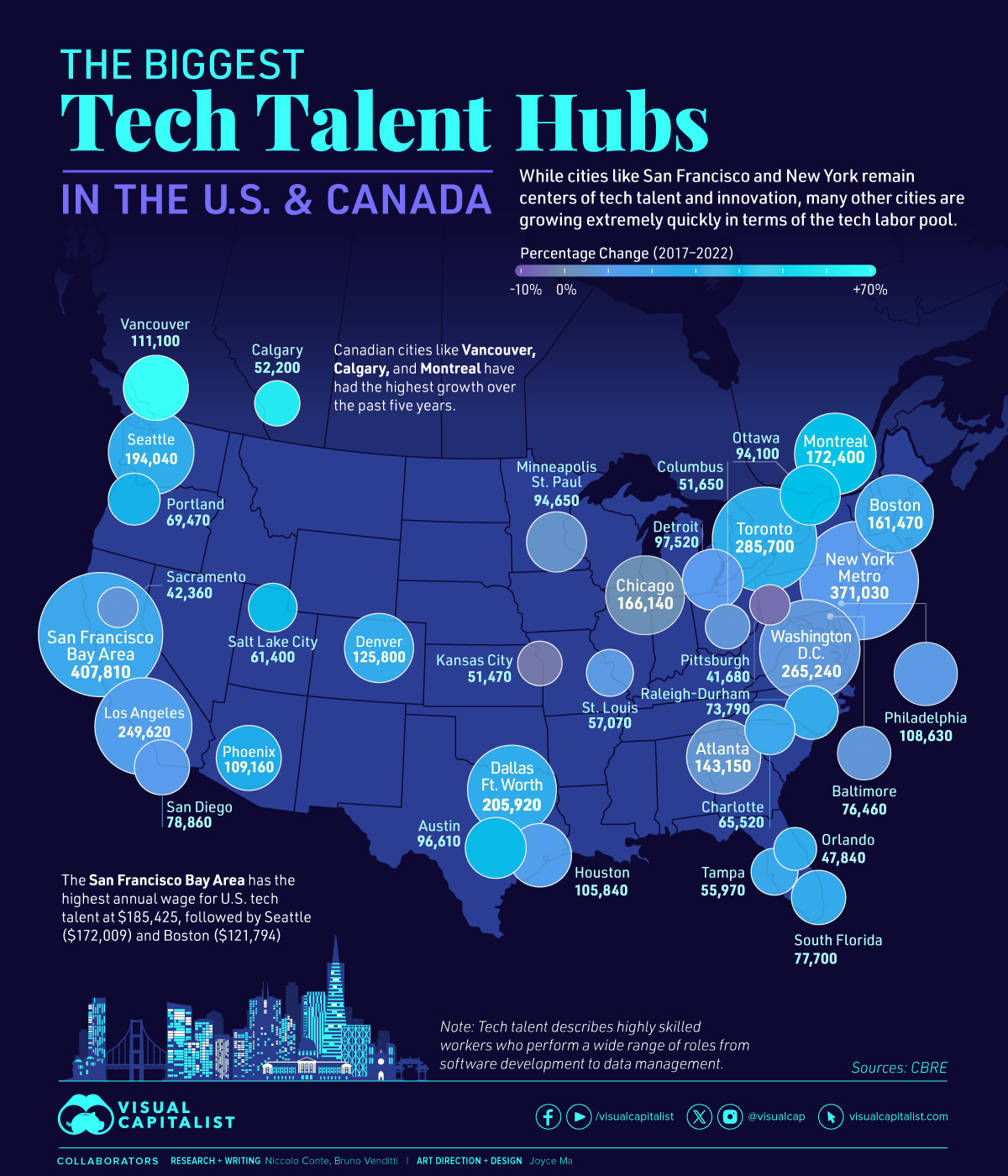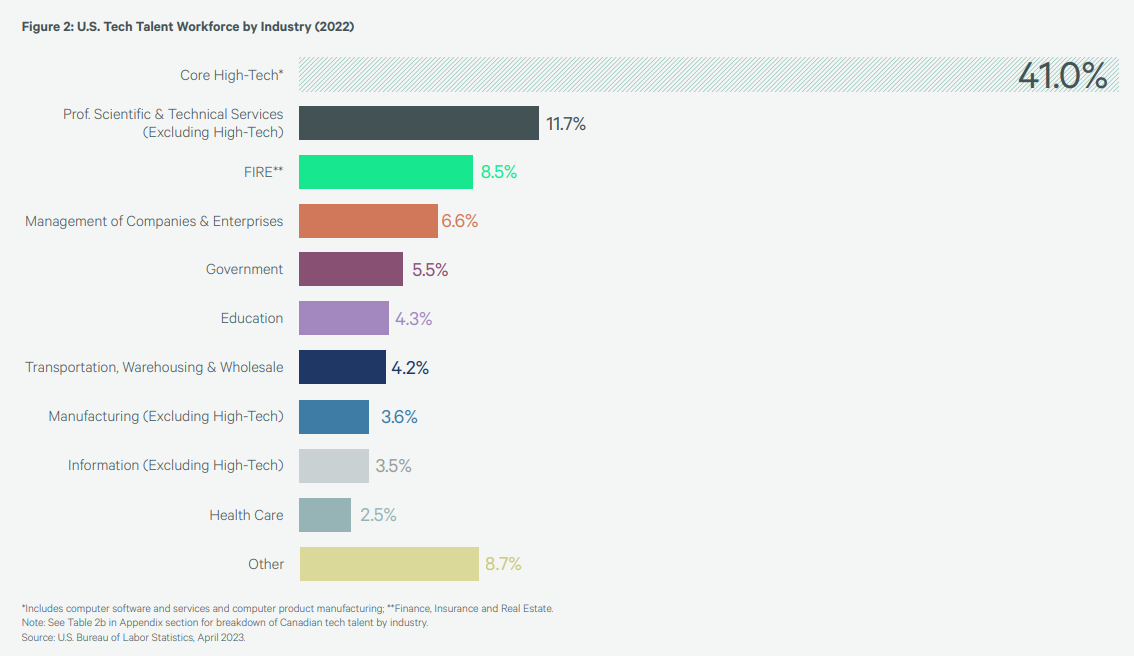Technology
Mapping the Biggest Tech Talent Hubs in the U.S. and Canada

Mapping the Biggest Tech Talent Hubs in the U.S. and Canada
While cities like San Francisco and New York remain centers of tech talent and innovation, many other cities are growing extremely quickly in terms of the tech labor pool.
This infographic draws from a report by CBRE to determine which tech talent markets in the U.S. and Canada are the largest. The data looks at the total workforce in the sector, as well as the change in tech worker population over time in various cities.
What is Tech Talent?
Tech talent represents a group of highly skilled workers in more than 20 technology-oriented occupations driving innovation across all industry sectors, ranging from software developers to systems and data managers.
Although these positions are concentrated within the high-tech industry, they are spread across all industry sectors.

Top tech talent markets are typically characterized by a substantial level of educational attainment and a significant concentration of young individuals. Forty-five of the top 50 talent markets have an educational attainment level above national averages.
The tech sector remains one of the top employers of highly skilled workers in North America, with over seven million workers.
California’s Bay Area, which includes Silicon Valley, remains the biggest tech hub, with a talent pool of 407,810 tech workers, compared to 378,870 in 2021.
| Market | Tech Workforce (2022) | Change (2017-2022) |
|---|---|---|
| San Francisco Bay Area | 407,810 | 23% |
| New York Metro | 371,030 | 11% |
| Toronto | 285,700 | 29% |
| Washington D.C. | 265,240 | 7% |
| Los Angeles/Orange County | 249,620 | 17% |
| Dallas/Ft. Worth | 205,920 | 28% |
| Seattle | 194,040 | 29% |
| Montreal | 172,400 | 43% |
| Chicago | 166,140 | 2% |
| Boston | 161,470 | 22% |
| Atlanta | 143,150 | 6% |
| Denver | 125,800 | 26% |
| Vancouver | 111,100 | 69% |
| Phoenix | 109,160 | 30% |
| Philadelphia | 108,630 | 7% |
| Houston | 105,840 | 12% |
| Detroit | 97,520 | 10% |
| Austin | 96,610 | 39% |
| Minneapolis/St.Paul | 94,650 | 4% |
| Ottawa | 94,100 | 40% |
| San Diego | 78,860 | 12% |
| South Florida | 77,700 | 24% |
| Baltimore | 76,460 | 5% |
| Raleigh-Durham | 73,790 | 24% |
| Portland | 69,470 | 34% |
| Charlotte | 65,520 | 21% |
| Salt Lake City | 61,400 | 39% |
| St. Louis | 57,070 | 7% |
| Tampa | 55,970 | 23% |
| Calgary | 52,200 | 61% |
| Columbus | 51,650 | 5% |
| Kansas City | 50,470 | -4% |
| Orlando | 47,840 | 26% |
| Sacramento | 42,360 | 7% |
| Pittsburgh | 41,680 | -6% |
| Cincinnati | 40,450 | 10% |
| Nashville | 39,180 | 36% |
| Cleveland | 38,130 | 6% |
| Quebec City | 36,400 | 34% |
| Indianapolis | 35,980 | 1% |
| Milwaukee | 35,260 | 14% |
| San Antonio | 33,470 | 7% |
| Virginia Beach | 31,210 | 17% |
| Edmonton | 31,100 | 45% |
| Waterloo Region, Canada | 29,700 | 52% |
| Richmond | 28,480 | 14% |
| Hartford | 27,500 | 6% |
| Inland Empire | 26,850 | 44% |
| Jacksonville | 23,620 | 17% |
| Madison | 23,530 | 45% |
The Bay Area also has the highest annual wage for U.S. tech talent at $185,425, followed by Seattle ($172,009) and Boston ($121,794)
Toronto remains the third tech hub in North America, just behind the San Francisco Bay Area and New York.
Emerging Tech Cities in Canada
Canada has attracted significant numbers of tech workers largely as a result of the country’s immigration-friendly national policy and labor cost advantage, according to a recent report from the Technology Councils of North America (TECNA) and Canada’s Tech Network (CTN).
In fact, Canadian cities like Vancouver, Calgary, and Waterloo have had the highest growth of tech workers over the past five years.
Between April 2022 and March 2023, 32,115 new workers came to Canada with the most migrating from India and Nigeria.
North America’s Next Tech Hubs
Despite the dominance of traditional tech hubs, the report also points to other cities that could receive tech talent over the next few years.
They are concentrated in the U.S. Midwest and South, like Boise (ID), Las Vegas (NE), Palm Bay (FL), and Birmingham (AL).
The report also highlights Winnipeg and Halifax as potential Canadian tech hubs.
Technology
Charting the Next Generation of Internet
In this graphic, Visual Capitalist has partnered with MSCI to explore the potential of satellite internet as the next generation of internet innovation.

Could Tomorrow’s Internet be Streamed from Space?
In 2023, 2.6 billion people could not access the internet. Today, companies worldwide are looking to innovative technology to ensure more people are online at the speed of today’s technology.
Could satellite internet provide the solution?
In collaboration with MSCI, we embarked on a journey to explore whether tomorrow’s internet could be streamed from space.
Satellite Internet’s Potential Customer Base
Millions of people live in rural communities or mobile homes, and many spend much of their lives at sea or have no fixed abode. So, they cannot access the internet simply because the technology is unavailable.
Satellite internet gives these communities access to the internet without requiring a fixed location. Consequently, the volume of people who could get online using satellite internet is significant:
| Area | Potential Subscribers |
|---|---|
| Households Without Internet Access | 600,000,000 |
| RVs | 11,000,000 |
| Recreational Boats | 8,500,000 |
| Ships | 100,000 |
| Commercial Aircraft | 25,000 |
Advances in Satellite Technology
Satellite internet is not a new concept. However, it has only recently been that roadblocks around cost and long turnaround times have been overcome.
NASA’s space shuttle, until it was retired in 2011, was the only reusable means of transporting crew and cargo into orbit. It cost over $1.5 billion and took an average of 252 days to launch and refurbish.
In stark contrast, SpaceX’s Falcon 9 can now launch objects into orbit and maintain them at a fraction of the time and cost, less than 1% of the space shuttle’s cost.
| Average Rocket Turnaround Time | Average Launch/Refurbishment Cost | |
|---|---|---|
| Falcon 9* | 21 days | < $1,000,000 |
| Space Shuttle | 252 days | $1,500,000,000 (approximately) |
Satellites are now deployed 300 miles in low Earth orbit (LEO) rather than 22,000 miles above Earth in Geostationary Orbit (GEO), previously the typical satellite deployment altitude.
What this means for the consumer is that satellite internet streamed from LEO has a latency of 40 ms, which is an optimal internet connection. Especially when compared to the 700 ms stream latency experienced with satellite internet streamed from GEO.
What Would it Take to Build a Satellite Internet?
SpaceX, the private company that operates Starlink, currently has 4,500 satellites. However, the company believes it will require 10 times this number to provide comprehensive satellite internet coverage.
Charting the number of active satellites reveals that, despite the increasing number of active satellites, many more must be launched to create a comprehensive satellite internet.
| Year | Number of Active Satellites |
|---|---|
| 2022 | 6,905 |
| 2021 | 4,800 |
| 2020 | 3,256 |
| 2019 | 2,272 |
| 2018 | 2,027 |
| 2017 | 1,778 |
| 2016 | 1,462 |
| 2015 | 1,364 |
| 2014 | 1,262 |
| 2013 | 1,187 |
Next-Generation Internet Innovation
Innovation is at the heart of the internet’s next generation, and the MSCI Next Generation Innovation Index exposes investors to companies that can take advantage of potentially disruptive technologies like satellite internet.
You can gain exposure to companies advancing access to the internet with four indexes:
- MSCI ACWI IMI Next Generation Internet Innovation Index
- MSCI World IMI Next Generation Internet Innovation 30 Index
- MSCI China All Shares IMI Next Generation Internet Innovation Index
- MSCI China A Onshore IMI Next Generation Internet Innovation Index
MSCI thematic indexes are objective, rules-based, and regularly updated to focus on specific emerging trends that could evolve.

Click here to explore the MSCI thematic indexes

-

 Technology1 week ago
Technology1 week agoCountries With the Highest Rates of Crypto Ownership
While the U.S. is a major market for cryptocurrencies, two countries surpass it in terms of their rates of crypto ownership.
-

 Technology1 week ago
Technology1 week agoMapped: The Number of AI Startups By Country
Over the past decade, thousands of AI startups have been funded worldwide. See which countries are leading the charge in this map graphic.
-

 Technology3 weeks ago
Technology3 weeks agoAll of the Grants Given by the U.S. CHIPS Act
Intel, TSMC, and more have received billions in subsidies from the U.S. CHIPS Act in 2024.
-

 Technology3 weeks ago
Technology3 weeks agoVisualizing AI Patents by Country
See which countries have been granted the most AI patents each year, from 2012 to 2022.
-

 Technology3 weeks ago
Technology3 weeks agoHow Tech Logos Have Evolved Over Time
From complete overhauls to more subtle tweaks, these tech logos have had quite a journey. Featuring: Google, Apple, and more.
-

 AI1 month ago
AI1 month agoRanked: Semiconductor Companies by Industry Revenue Share
Nvidia is coming for Intel’s crown. Samsung is losing ground. AI is transforming the space. We break down revenue for semiconductor companies.
-

 Maps7 days ago
Maps7 days agoMapped: Southeast Asia’s GDP Per Capita, by Country
-

 Markets2 weeks ago
Markets2 weeks agoVisualizing Global Inflation Forecasts (2024-2026)
-

 United States2 weeks ago
United States2 weeks agoCharted: What Southeast Asia Thinks About China & the U.S.
-

 United States2 weeks ago
United States2 weeks agoThe Evolution of U.S. Beer Logos
-

 Healthcare1 week ago
Healthcare1 week agoWhat Causes Preventable Child Deaths?
-

 Energy1 week ago
Energy1 week agoWho’s Building the Most Solar Energy?
-

 Markets1 week ago
Markets1 week agoMapped: The Most Valuable Company in Each Southeast Asian Country
-

 Technology1 week ago
Technology1 week agoMapped: The Number of AI Startups By Country







